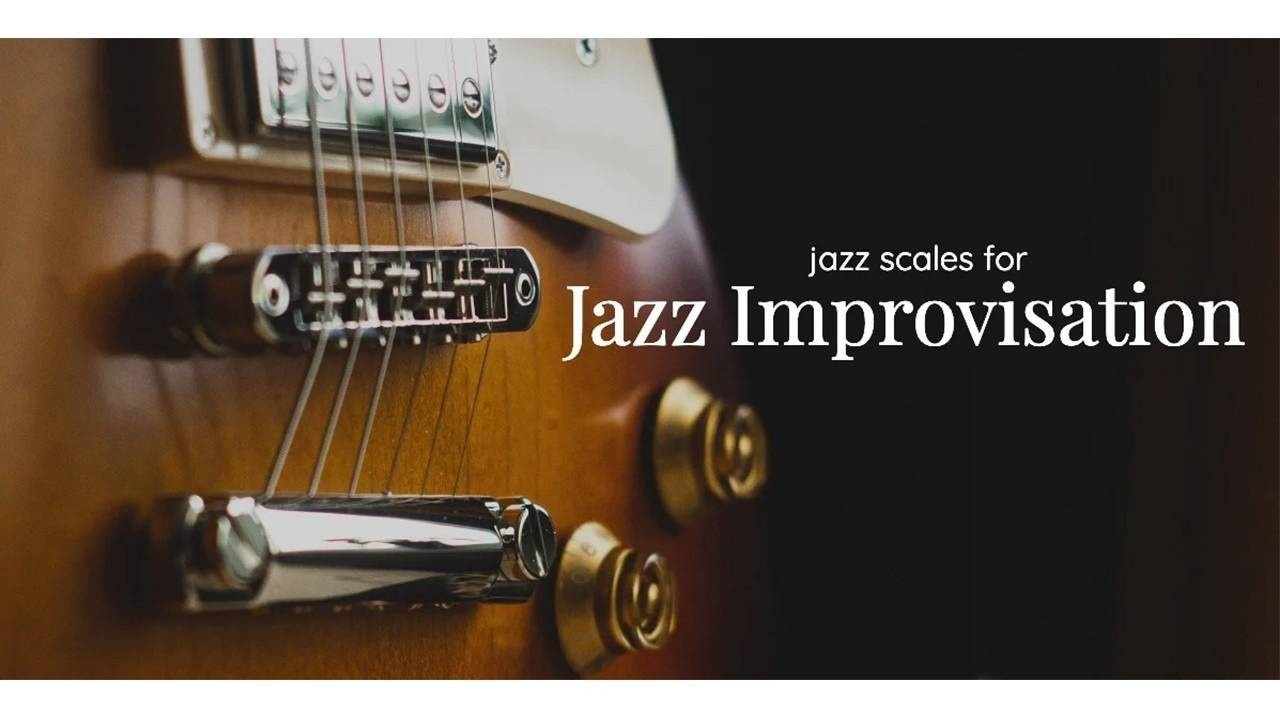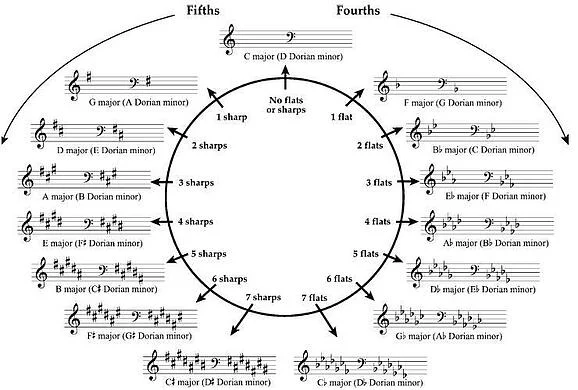
Learn Jazz Scales for Jazz Improvisation
Jan 17, 2021Reference for Most Common Scales for Jazz Guitar
Jazz improvisation depends on "playing the right notes". We can achieve this by carefully choosing scales in the appropriate context!
Here we'll provide you with a reference on how to effectively use the major scale as a reference for building other scales. Plus, the dorian and mixolydian modes which are related to the major scale itself.
With those three, you can start sounding great over the ii-V-I progression!
This quick guide will help you learn about not only the most typical scales on their own, but also show you how to use the scales in context. That's probably the most important factor in learning to apply jazz scales to standard progression. Note that this article will focus on the ii-V-I chord progression, the infamous chord sequence found in pretty much every jazz standard.
It may also be helpful to check out our beginner's guide to improvisation here to go along with this blog post!
How to Learn Jazz Improvisation
Using formulas is the best and most convenient way to write down, read, learn and memorize jazz scales. We use numbers instead of notes so you can easily apply the scale formula starting on any note. Essentially, we relativize scale degrees and C D E F G becomes 1 2 3 4 5. Easy!
The basis for the system of notation is the major scale structure.
This: C D E F G A B (C)
Becomes: 1 2 3 4 5 6 7 (1)
The Major Scale IS the prime reference for building all the other scales!
At first, you should learn the scales that are very closely related to the major scale (i.e. different only by a few notes). Later, you'll be able tackle more challenging formulas (other more complex jazz guitar scales) with a solid foundation.
The VIDEO - Is This Jazz Education?!?
Before going any further, just watch this video. Not too much jazz theory, I promise! Basically, I demonstrate the three basic chords, scales and arpeggio sounds needed for jazz guitar improvisation on a basic II-V-I cadence.
This means that every chord in the sequence gets assigned exactly one scale. Pretty neat, uh?
After you get this under your fingers, your can get going and create you own solos.
The chords, scales and arpeggios from the video are found in this PDF file here ...
And now for some more theory on scales in jazz. Are you ready for this? :-)
The 3 "Biggies": Major, Minor and Dominant

Please note:
- The major scale symbol is often a little triangle. You can also see the nomenclature "maj7" on charts.
- The major scale is also known as the Ionian mode.
- The dominant 7th scale has only one note different from the major.
- The dominant 7th scale is also known as the Mixolydian mode (and it is found on the 5th degree of the major scale).
- That basic minor sound is also known as the Dorian mode (and it is found on the 2nd degree of the major scale).
- This minor scale (Dorian) has only two notes different from the major scale.
- The minor symbol is often a little minus sign. You can also see the nomenclature "minor7" or even just "m7" on charts.
Learn Jazz Improvisation: Memorization Suggestions
Memorizing the three basic scale formulas is primordial. Then, spell out the major, mixolydian (dominant) and minor (dorian) scales. I mean, recite the names of the note out loud! This helps a lot. If you do all three scales from root C, it goes like this...
C major: C D E F G A B

C mixolydian: C D E F G A Bb

C Dorian: C D Eb F G A Bb

It also helps to think about which scale degrees are different in each scale. Compared to the major scale, mixolydian has a b7, and dorian has a b3 and b7.
I strongly suggest that you pick *one* of the three scales and recite it in all the 12 keys.
See this page for different cycles you can practice with (including the invaluable cycle of fourths). All memorized? Let's go practice the three basic jazz guitar scales on your instrument now!
Jazz Scales Practice Suggestions
To learn these three jazz scales well, you have to think about the following at all times:
- Go slowly;
- Maintain a good sound on each note;
- Knowing exactly what scales / notes your are playing!
- Listen closely to the result.
- Learn the "personality" of the altered notes! They're what makes each scale unique.
Jazz Guitar Tips to Get Going With Jazz Scales
Here's a series of videos (a YouTube playlist) to help you, step by step, on how to get started with everything that has been discussed on this page:
Some Practice Steps for Jazz Scales
- Pick one of the above scales.
- In *any* fingering: play the chosen scale from degrees 1 to 7 and back down. ONLY from 1 to 7, so in C major, you would play C D E F G A B.
- Repeat in a few keys around the instrument / fretboard. Go slow, get accustomed to the sound.
- Learn the scale starting on string 6 (biggest string)
- Then learn the same scale starting on strings 5, 4, 3 and 2. Explore different starting fingers for each scale.
- Consolidate between 2 and 4 fingerings that work well for you. Not more. Don't learn everything in all positions (not yet!)
- You'll want to do that previous step carefully for each scale, because when the formula changes, so do the fingerings!
- Practice the scale from degrees 1 to 7 and back down 7 to 1 in all the twelve keys. Use the cycle of fourths as you root order: C, F, Bb, Eb, Ab, etc.
- Practice the same as last step but only ascending the scale (1 to 7)
- Same as last step but only descending the scale (7 to 1)
For the last three steps above: play in time!!! I highly recommend setting the metronome on 2&4, like shown in this video.
More Practice Steps to Learning Jazz Improv
You need to know the each of the scales independently to be able to tackle the ones presented below. More challenging stuff, but still doable with patience.
We are going to be mixing the three scales together: practice the Dorian, Mixolydian in Major jazz scales together in the context of the II-V-I progression.
For example:
On the progression Dm7 - G7 - Cmaj7 (this is a II-V-I in C major)
Play D dorian (minor) ascending and descending
then G mixolydian (dominant) ascending and descending
then C major ascending and descending
Then repeat with just the ascending version.
Then repeat with just the descending version.
Last but not least, repeat with a the II-V-I progression in all the remaining keys.
Gm7 - C7 - Fmaj7
Cm7 - F7 - Bbmaj7
Fm7 - Bb7 - Ebmaj7
Bbm7 - Eb7 - Abmaj7
Ebm7 - Ab7 - Dbmaj7 .... (or D#m7 - G#7 - C#maj7)
Abm7 - Db7 - Gbmaj7 .... (or G#m7 - C#7 - F#maj7)
C#m7 - F#7 - Bmaj7
F#m7 - B7 - Emaj7
Bm7 - E7 - Amaj7
Em7 - A7 - Dmaj7
Am7 - D7 - Gmaj7
Congratulations! If you can play the above suggestions well enough, your jazz language can develop in many beautiful ways (in phrasing, ornamentations, licks, etc.) Learning, memorizing and playing those three basic jazz scales will go a long way for your jazz improv.










